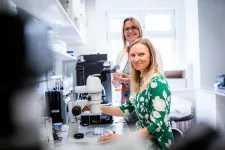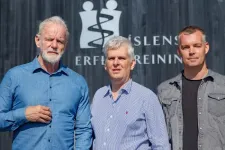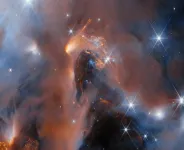(Press-News.org) Sophia Antipolis, France – 27 August 2024: Cardiovascular disease (CVD) remains the most common cause of death across Europe but while CVD mortality rates are generally decreasing, the decline is much less in middle-income than in high-income countries, according to new data from the European Society of Cardiology (ESC) Atlas of Cardiology, published in the European Heart Journal.1
The fourth edition of ESC Atlas statistics again demonstrate that CVD is the most common cause of death in the 55 ESC member countries studied. There are over 3 million deaths due to CVD per year – the equivalent of 8,500 deaths per day – which represents 37.4% of all deaths annually. Of note, age-standardised mortality rates (ASMRs) were at least 2.5-times higher in middle-income compared with high-income countries. Between 1990 and 2021, median CVD ASMRs decreased by more than 50% in all high-income countries, but in middle-income countries, the decrease was less than 12%.
According to the latest data from ESC member countries:
CVD mortality is higher in middle-income countries (46% of all deaths in males; 53% of all deaths in females) than in high-income countries (30% of all deaths in males; 34% of all deaths in females).
The estimated age-standardised potential years of life lost was more than 3-times higher in middle-income compared with high-income countries.
Professor Adam Timmis, first author of the report, said: “The new statistics on deaths due to CVD illustrate the scale of the problem and underscore the urgent need for effective strategies in prevention and management. The inequalities between middle- and high-income ESC member countries likely reflect heterogeneous exposures to a range of environmental, socioeconomic and clinical risk factors.”
According to the latest data from ESC member countries:
Around one-quarter of persons aged ≥15 years were estimated to be tobacco-product users (25.4%), with rates as high as 40.9% among males in middle-income countries.
Hypertension affected >40% of both sexes in middle-income countries vs. <30% of females and <40% of males in high-income countries.
The prevalence of diabetes was 7.7% in middle-income countries vs. 6.0% in high-income countries.
More than half (55%) of people were overweight and 17% were obese, with similarly high rates for middle-income and high-income countries.
Professor Timmis also pointed to new data suggesting that treatment factors may contribute to inequalities in CVD mortality, with middle-income countries substantially under-resourced in terms of specialist staffing, and diagnostic and therapeutic procedure rates compared with high-income countries. Across ESC member countries, there were twice as many cardiologists per million inhabitants in high-income than middle-income countries (100 vs. 55, respectively). In addition, middle-income countries reported lower rates per million of percutaneous coronary intervention (1,355 vs. 2,330, respectively), transcatheter aortic valve implantation (4.0 vs. 153.4) and pacemaker implantation (147.0 vs. 831.9) compared with high-income countries.
The data presented in the fourth edition have been enriched with economic data from the ESC’s Burden of CVD project developed in collaboration with Nuffield Department of Population Health, Oxford University.2 Overall, CVD is estimated to cost the EU economy €282 billion annually – a cost of €630 per person, ranging from €381 in Cyprus to €903 in Germany. Of the total cost of CVD, 46% was due to healthcare, 9% to social care, 28% to informal care and 17% to productivity loss.
Professor Panos Vardas, a past president of the ESC and Chief Strategy Officer of the ESC’s European Heart Agency in Brussels, said: “Informed decision-making is key to tackling the challenges posed by CVD, but this can only happen with accurate and comprehensive data. Since the first ESC Atlas statistics were published in 2017, we have gathered compelling evidence on the clinical, economic and societal harms of CVD, and the need for targeted action, especially in those ESC member countries where the burden of disease is the greatest.”
The ESC Atlas of Cardiology project is widely recognised as a pivotal tool for leveraging cardiovascular care. It presents the evidence of trends, disparities, gaps and associations between fundamental variables, not just as one snapshot, but over time. Up-to-date statistics enable policymakers, healthcare providers and researchers to allocate resources efficiently, design targeted interventions and monitor the progress of public health initiatives. Atlas data were recently presented to EU health ministers in ongoing discussions towards building national and EU Cardiovascular Health Plans.
In addition to publications, the ESC Atlas has a new website where 300 CVD-related variables from ESC member countries can be freely accessed, with downloadable comparable graphs and charts across ESC countries. Furthermore, ESC Cardiovascular Realities 20243 presents the data in the context of policy change to support heart health.
“The ESC is committed to advancing cardiovascular health through research, education and advocacy. ESC Atlas is a testament to that commitment and will serve as a valuable resource for all stakeholders involved in cardiovascular health,” concluded Professor Vardas.
ENDS
Notes to editor
Funding: The ESC Atlas of Cardiology project is fully funded by the European Society of Cardiology.
Disclosures: All authors declare that they have no conflict of interest relevant to this study.
Delegates at ESC Congress 2024, which takes place in London from 30 August to 2 September, can navigate the ESC Atlas data at the Research & Data stand in the Exchange Area. In addition, they can attend a Special Session, entitled ESC cardiovascular statistics, the Atlas project: leveraging evidence-based care4 to learn more about the latest data, namely the trends, the ‘challenges and champions,’ the economic impact of CVD and the future of cardiac care.
References and notes
1Timmis A, Aboyans V, Vardas P, et al. European Society of Cardiology: the 2023 Atlas of Cardiovascular Disease Statistics. Eur Heart J. 2024. https://doi.org/10.1093/eurheartj/ehae466 published on Tuesday 27 August 2024.
2Luengo-Fernandez R, Walli-Attaei M, Gray A, et al. Economic burden of cardiovascular diseases in the European Union: a population-based cost study. Eur Heart J. 2023;44:4752–4767.
3ESC Cardiovascular Realities 2024. An Illustrated Atlas of Key European Statistics. Available at: escardio.org/Research/ESC-Atlas-of-cardiology from Tuesday 27 August 2024.
4A special session, ‘ESC cardiovascular statistics, the Atlas project: leveraging evidence-based care,’ takes place on Friday 30 September 2024 at 16.15 to 17.15 BST in room Valletta.
ESC Press Office
Tel: +33 6 61 40 18 84
Email: press@escardio.org
The hashtag for ESC Congress 2024 is #ESCCongress
Follow us on X @ESCardioNews
Journalists are invited to become accredited and register here.
Check out the ESC Media and Embargo Policy.
About ESC Congress 2024
It is the world’s largest gathering of cardiovascular professionals, disseminating ground-breaking science both onsite in London and online – from 30 August to 2 September. Explore the scientific programme. More information is available from the ESC Press Office at press@escardio.org.
About the European Society of Cardiology
The European Society of Cardiology brings together health care professionals from more than 150 countries, working to advance cardiovascular medicine and help people lead longer, healthier lives.
END
Cardiovascular disease disproportionately affects middle-income countries
2024-08-27
ELSE PRESS RELEASES FROM THIS DATE:
Kamikaze termites protect their colony with the help of a special enzyme. Its secrets have been uncovered by scientists from IOCB Prague
2024-08-27
Researchers from the Institute of Organic Chemistry and Biochemistry of the Czech Academy of Sciences, in cooperation with colleagues from the Faculty of Tropical AgriScience of the Czech University of Life Sciences in Prague, are unravelling the mysteries of the life of termites. Colonies of the species Neocapritermes taracua boast a unique type of defence, which is provided by worker termites at the end of their lives. When attacked, they sacrifice themselves by setting off an explosive chemical reaction, the ...
Metal baseball bats still help Little Leaguers hit a little better
2024-08-27
PULLMAN, Wash. – While meant to simulate wood bats, regulation USA Baseball metal bats are more forgiving than wood for young players who might not connect with the ball on a bat’s optimal “sweet spot.”
After testing wood bats and two types of metal bats with youth players, Washington State University researchers found that the exit speed of a hit ball was as much as 5% faster with metal bats over wood. Analyzing the data, they found that the performance of the USA Baseball metal bats at the sweet spot was similar to wood. It was when the hits were on less optimal areas that there was a bigger difference.
“There’s ...
AI spots cancer and viral infections at nanoscale precision
2024-08-27
Researchers at the Centre for Genomic Regulation (CRG), the University of the Basque Country (UPV/EHU), Donostia International Physics Center (DIPC) and the Fundación Biofisica Bizkaia (FBB, located in Biofisika Institute) have developed an artificial intelligence which can differentiate cancer cells from normal cells, as well as detect the very early stages of viral infection inside cells. The findings, published today in a study in the journal Nature Machine Intelligence, pave the way for improved diagnostic techniques and new monitoring strategies for disease.
The tool, AINU (AI of the NUcleus), scans high-resolution images of cells. The ...
AI-based virtual voice assistant successfully bridges care gap for heart patients
2024-08-27
London, United Kingdom – 27 August 2024: Clinical follow-up using virtual voice technology helped identify complications after transcatheter aortic valve implantation (TAVI) with a high degree of patient satisfaction, according to research presented at ESC Congress 2024.1
Explaining the rationale for the development of the virtual voice assistant for TAVI patients, study author Dr. Marta Herrero Brocal from the Dr. Balmis General University Hospital of Alicante, Spain said: “Aortic valve stenosis is common, especially in the ageing population.2 It can be treated with surgery ...
Urban noise pollution may impact cardiovascular risk prediction and prognosis after a heart attack
2024-08-27
London, United Kingdom – 27 August 2024: Research from two studies in different European cities1,2 highlights that urban noise pollution has a significant negative impact on heart health, according to data presented at ESC Congress 2024.
“The DECIBEL-MI study shows that young patients aged 50 years or less who had a myocardial infarction (MI) had been exposed to higher levels of noise than the general population. The study demonstrates that urban noise could significantly increase the risk of early-onset MI in young people with low traditional risk factors. Including ...
Discovery of a rare genotype causing primary ovarian insufficiency
2024-08-27
Scientists at deCODE genetics and collaborators, have identified a sequence variant in the CCDC201 gene that when inherited from both parents homozygous causes menopause on average nine years earlier.
deCODE genetics, a subsidiary of Amgen, and collaborators from Iceland, Denmark, the UK, and Norway published a study in Nature Genetics today revealing a rare genotype with a significant impact on women's health.
Age at menopause significantly affects fertility and disease risk. This research focused on ...
Menopause potentially linked to adverse cardiovascular health through blood fat profile changes
2024-08-27
London, United Kingdom – 27 Aug 2024: New research presented at the ESC Congress 2024 in London, UK (30 August – 2 September) shows that women in the menopause transition period show changes in their blood cholesterol profiles which could have an adverse impact on their cardiovascular health.
“There is an increase in ‘bad’ low-density type lipoprotein (LDL) particles and a decrease in ‘good’ high-density lipoprotein particles (HDL) that takes place during and after the menopause transition,” says study author Dr Stephanie Moreno, University of Texas Southwestern Medical Center, Dallas, TX, USA. “Taken ...
Women in global fisheries industry fall through the safety net
2024-08-27
Millions of women who work in the fisheries industry are being left behind as technologies develop to counter the effects of climate change and economic pressures.
New research led by the University of East Anglia (UEA) looks specifically at post-harvest fisheries and aquaculture, where women constitute 50 per cent of the total workforce. Despite their significant contributions women often remain invisible, are unpaid or underpaid, their work seen as an extension of household work.
The findings, ‘A systematic review of the impact of post-harvest aquatic food ...
In six new rogue worlds, Webb Telescope finds more star birth clues
2024-08-27
The James Webb Space Telescope has spotted six likely rogue worlds—objects with planetlike masses but untethered from any star’s gravity—including the lightest ever identified with a dusty disk around it.
The elusive objects offer new evidence that the same cosmic processes that give birth to stars may also play a common role in making objects only slightly bigger than Jupiter.
“We are probing the very limits of the star forming process,” said lead author Adam Langeveld, an astrophysicist at Johns Hopkins University. “If you have an object that looks like a young Jupiter, is it possible that ...
Star lives and afterlives
2024-08-27
A two-faced star, a star as massive as the Sun but as compact as the Moon, and star ‘corpses’ that engulf entire planets and disrupt planetary orbits. Ilaria Caiazzo, an astrophysicist who has made stunning discoveries, joins the Institute of Science and Technology Austria (ISTA) as a new assistant professor. Her path led her from philosophy to studying stellar evolution and death while managing her broad interests including movie production.
Ilaria Caiazzo has always had a broad spectrum of interests. Her path to astrophysics started in philosophy and ...




